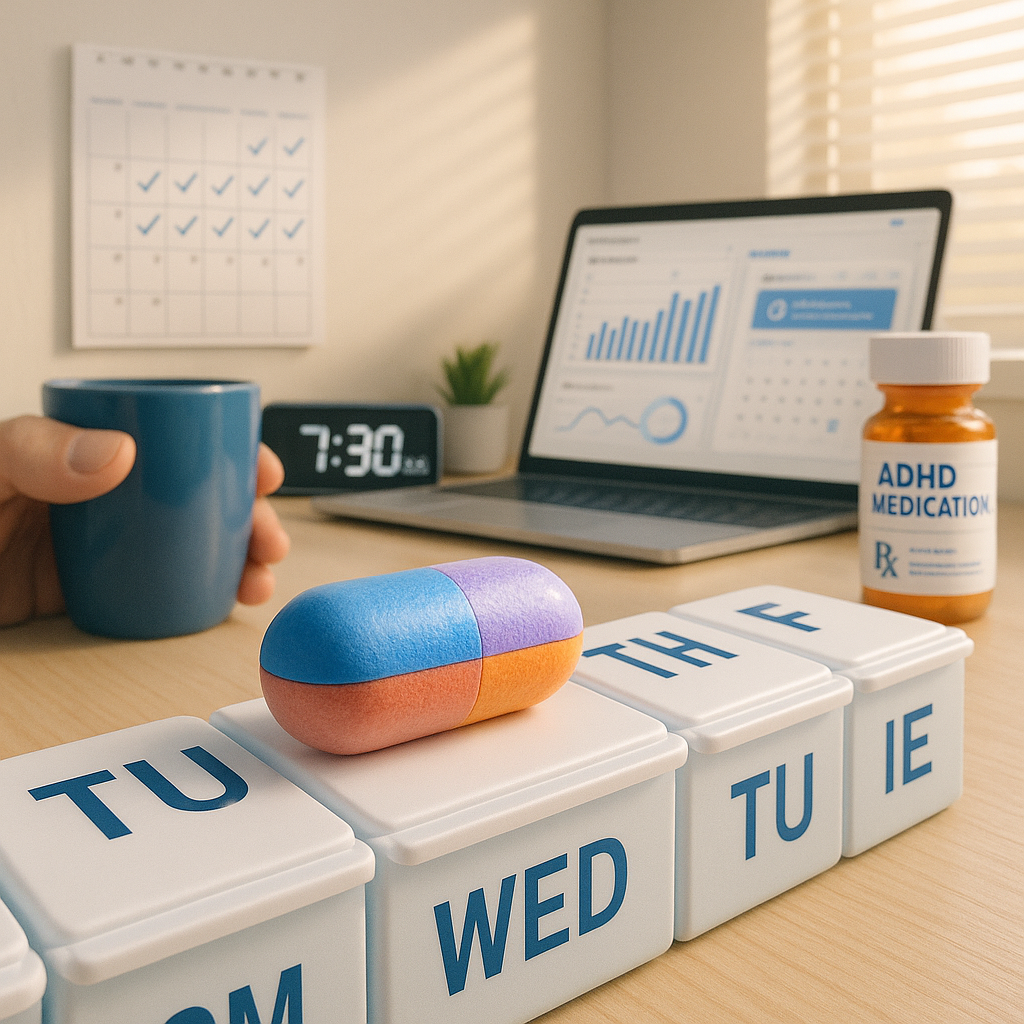Key Takeaways
- ADHD focus doesn’t stem from sheer willpower. It thrives on the right habits and systems that harness neurodivergent strengths. The “ADHD Focus Checklist” introduces actionable, research-backed daily routines designed to minimize distractions and enable consistent flow, making deep work more attainable. Even on chaotic days, these can be helpful.
- Transform your mornings into launchpads for productivity. Establishing repeatable routines—even simple steps like getting sunlight, staying hydrated, and moving your body—helps reorient the ADHD brain from scattered to engaged before distractions set in.
- Chunk tasks to conquer overwhelm. Breaking work into small, time-bound “focus sprints” makes big goals more manageable, supports sustained attention, and turns progress into a cycle of dopamine-driven rewards.
- Shape environments that work with your unique wiring. Intentionally designing your space with sensory cues, minimal clutter, and motivating background music reduces friction and signals your brain it’s time to focus.
- Make structure visible with checklists. Externalizing to-dos using physical or digital checklists offloads mental clutter, lowers the risk of task paralysis, and keeps priorities front and center when working memory slips.
- Use micro-breaks as fuel, not as distractions. Scheduled, short resets maintain stamina and prevent hyperfocus crashes, making it easier to dive back into flow without spiraling into distraction.
- Employ body-first habits for brain-level gains. Basics like hydration, movement, and a protein-rich breakfast spark sharper attention and stabilize energy, directly supporting periods of deep focus.
- Celebrate “tiny wins” to build momentum. Recognizing small victories each day retrains your brain to associate routines with success, fostering feedback loops that help replace avoidance and self-criticism with progress.
- Proactively design out distractions. Disabling digital alerts, setting up dedicated “focus zones,” and having prepared scripts for interruptions minimize willpower battles before they even start.
Mastering focus as a neurodivergent creator starts with simple tools, not superhuman effort. Up next, we’ll break down every checklist habit, explore the science behind each step, and help you personalize your daily structure for real-life, sustainable flow. Focus becomes a natural outcome, not an uphill battle.
Introduction
Focus isn’t something you can just summon when you need it most. Especially if your ADHD brain is wired for high curiosity, creativity, and, sometimes, a bit of chaos. The line between a day filled with scattered thoughts and a productive, energized day often hinges on your daily habits and environment, not some ironclad sense of willpower.
That’s the value of the ADHD focus checklist. By transforming research-backed habits into visible, repeatable routines, you can overcome distractions and welcome flow states on your own terms. Whether you’re kickstarting your morning with energizing rituals, chunking big goals into actionable steps, or building “distraction-proof” zones, these strategies empower you to use your strengths and turn everyday chaos into deep, steady progress.
Now, let’s explore the daily habits proven to help you design a flow-friendly structure. With a little intention, focus turns into momentum you can trust.
Why the ADHD Focus Checklist Works
The strength of an ADHD focus checklist is its ability to make executive function visible and to create a steady stream of dopamine boosts throughout your day. Since ADHD brains process dopamine differently, designing systems that align with your natural neurochemistry just makes sense.
Recent research in the Journal of Attention Disorders demonstrates that people with ADHD who rely on structured external systems see a 40% increase in task completion rates. This is not just about productivity; it’s about leveraging implementation intentions. These are specific plans that bypass common executive function challenges by translating intentions into concrete steps.
The Neuroscience of Structure
Our ADHD operating system thrives when three conditions are met:
- Novelty: Engaging, changing stimuli that capture our attention.
- Challenge: Tasks pitched at that sweet spot between easy and impossible.
- Immediate feedback: Clear, quick signals that we’re headed in the right direction.
A thoughtful checklist weaves these elements together by chunking overwhelming tasks, offering regular feedback, and delivering quick wins. In effect, you’re creating a personalized video game progression system that fuels motivation and focus throughout your day.
Diverse fields have begun to recognize the advantages of structured external supports. In corporate settings, visible project boards drive accountability and momentum. In healthcare, checklists for medication and self-care routines improve treatment adherence and reduce errors, especially among neurodivergent individuals. Even in education, personalized assignment trackers help students manage time and reduce overwhelm.
Morning Ritual: Setting the Stage for Focus
A strong morning routine is the foundation for optimal dopamine regulation and focused attention. Rather than wrestling with executive dysfunction in the early hours, empower yourself with a ritual that eliminates decision fatigue and sparks attention.
The 3-Part Morning Stack
- Physical Reset (5–10 minutes)
- Light exposure: Step outside or sit by a sunny window for five minutes.
- Movement: Incorporate light stretching, yoga, or brief exercise to stimulate your nervous system.
- Cold splash: Rinse your face or hands in cold water to kickstart wakefulness.
- Mental Preparation (10 minutes)
- Identify your top three priorities for the day.
- Review your calendar and block out focused work periods.
- Set your phone or devices to “focus mode” to shield against early distractions.
- Environment Setup (10 minutes)
- Tidy your primary workspace to minimize visual distractions.
- Fill up your water bottle as a cue for hydration.
- Start a focus-friendly playlist or white noise for background stimulation.
Each step primes your mind and space, so your first work session feels less like an uphill battle and more like a natural start.
Creating dependable morning routines also translates well in other industries. Healthcare professionals benefit from pre-shift checklists to ensure essential tasks are never overlooked. Teachers use structured morning rituals in classrooms to anchor routines for students with attention differences, helping entire classrooms start on the right foot.
Task Chunking: The ADHD Time Block Method
Traditional time management techniques often falter for neurodivergent minds because they don’t consider fluctuations in focus and time perception. Instead, the Focus Flow Method offers a flexible yet structured format:
The 2-1-2 Framework
- 2 hours: Deep focus work (divided into 25-minute concentration sprints)
- 1 hour: Administrative tasks or activities that require less focus
- 2 hours: Creative or high-interest projects that absorb your attention
Between each block, insert a purposeful dopamine reset; a 10-minute activity that refreshes your mind and prevents fatigue. Suggested resets include:
- Quick bursts of exercise (like jumping jacks or a brisk walk)
- Playing with a pet for some instant joy
- Sketching or doodling to shift mental gears
- Moving around while listening to music
In corporate and educational settings, similar chunking strategies are used to maintain engagement. Financial analysts manage deep analysis and administrative reporting in distinct blocks, while teachers structure lessons to alternate between focused work and active breaks, supporting attention for all students.
Environment Design for Maximum Focus
Your physical environment substantially shapes your ability to focus. Setting up a “Focus Zone” transforms your workspace into an ally, sending clear signals to your brain that it’s time to engage.
The Focus Zone Checklist
- Visual Clarity
- Keep your desk clear except for the current project or task.
- Use cable management tools to minimize clutter and reduce distraction.
- Incorporate natural elements (like plants or wooden textures) to foster calm and restore attention.
- Sensory Optimization
- Prepare noise-canceling headphones for auditory focus.
- Adjust lighting to eliminate glare and spotlight your work area.
- Maintain a comfortable, consistent temperature (ideally between 68–72°F).
- Transition Triggers
- Choose a specific scent (such as rosemary or mint) reserved for work sessions.
- Put on designated “work glasses” or a special hat to set a psychological cue.
- Use physical timers or a visible countdown clock to mark the start and end of focus sprints.
Such environmental design can be a game changer in diverse fields. Legal professionals set up organized desks and use noise-reducing headphones during document review. In marketing agencies, teams designate “quiet zones” with visual dividers and curated playlists to boost concentration.
Strategic Breaks: The Reset Protocol
ADHD brains benefit from frequent, structured breaks, but without a plan these pauses can easily spiral into unproductive downtime. The Reset Protocol ensures breaks serve as stamina boosters rather than distractions.
The 3-3-3 Break System
- 3-Minute Micro-Breaks
- Stand up and gently stretch.
- Take several deep, intentional breaths.
- Refill your water bottle or grab a healthy snack.
- 30-Minute Power Breaks
- Go for a short nature walk for a burst of fresh air.
- Fit in a quick home workout.
- Take a brief, restorative power nap.
- 3-Hour Reset Points
- Completely reset your environment; clear your space, reset lighting.
- Eat a full, uninterrupted meal away from your desk.
- Connect with a friend or colleague for a social energy boost.
This intentional approach mirrors strategies seen in other high-stakes settings. Surgeons schedule short recharge periods during long operations, and professional athletes break for quick rehydration and mental resets between intense bouts of focus. Even data scientists and developers follow “pomodoro” cycles and longer breaks to prevent mental fatigue and maintain creative insight.
Celebrating Wins: The Dopamine Reward System
Acknowledging progress is vital for building sustainable motivation. By setting up clear ways to mark small and large wins, you condition your brain to seek out productive effort rather than avoidance.
Daily Victory Track
- Small Wins: Tick off tasks on your visible checklist.
- Medium Wins: Celebrate with a quick dance, high-five, or victory pose.
- Big Wins: Document major accomplishments in a dedicated “Success Journal,” noting details and key learnings.
Weekly Recognition
Create a “Focus Stats” tracker to measure:
- Total focused hours achieved
- Number of tasks completed
- Occurrences of flow states
- Specific challenges overcome
These celebration rituals have proven successful in various fields. In education, “sticker charts” or digital badges motivate students to stay engaged. In finance and sales, teams reward milestone achievements with leaderboards and peer recognition, turning progress into a community event.
Personalizing Your System
A checklist is not a one-size-fits-all solution; personalizing yours ensures it adapts to your evolving needs and patterns.
The 2-Week Experiment Method
- Track Your Current State
- Document your energy and attention levels during the day.
- Notice when focus comes most easily or feels hardest.
- Identify common distractions and the moments they strike.
- Record which tasks you actually complete.
- Test One Change at a Time
- Add or adjust a single new habit or technique.
- Log your experiences daily (both successes and surprises).
- Measure how changes impact your sustained focus.
- Evaluate and Adjust
- After two weeks, assess the results.
- Keep the strategies that worked best.
- Tweak or combine promising practices.
- Swap out anything that didn’t serve you for new experiments.
This adaptive approach is echoed in business and healthcare settings. Startups run iterative “sprints,” evaluating tactics every few weeks. Healthcare professionals trial different routines to improve patient engagement. Even athletes tweak nutrition and practice schedules to discover their personal formulas for peak performance.
Conclusion
Adopting an ADHD focus checklist isn’t just about boosting productivity. It’s a science-informed strategy to align your daily routines with the way neurodivergent minds truly work. By bringing executive demands into the open with visual cues and leveraging strategic rewards, checklists transform fleeting motivation into lasting momentum. Integrating rituals like the morning stack, flexible time blocks, thoughtfully designed environments, and frequent resets empowers you to channel your creativity and intensity into meaningful progress.
Above all, remember that the most effective systems are dynamic. Continual self-experimentation and honest adaptation are crucial, especially for neurodivergent professionals and solopreneurs who want growth that sticks. Treat every challenge as a chance for mastery; see your unique operating system as your greatest competitive advantage.
As the landscape of work and creativity evolves, your aptitude for designing and refining focus systems will set you apart. Whether in business, education, healthcare, or personal growth, those who can harness their strengths, adapt quickly, and celebrate each step forward will thrive. Let your focus checklist be both your daily roadmap and your ongoing celebration of what makes your mind not just different, but brilliant.





Leave a Reply